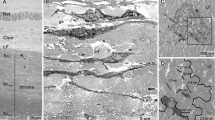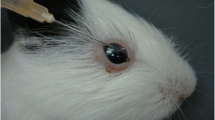Abstract
Background
Scleral cross-linking (SXL) by riboflavin and light application has been introduced as a possible treatment to increase scleral tissue stiffness and to inhibit excessive axial elongation of highly myopic eyes. We evaluated an ocular tissue damage threshold for blue light irradiation, and used SXL treatment to induce eye growth inhibition.
Methods
The sclera of 3-week-old rabbits (39 pigmented and 15 albino rabbits) were treated with different blue light intensities (450 ± 50 nm) and riboflavin. Alterations and a damage threshold were detected in ocular tissues by means of light microscopy and immunohistochemistry. The influence of SXL on the eye growth was examined in 21 young rabbits and was measured by using A-scan ultrasonography, micrometer caliper, and for selected eyes additionally by MR imaging.
Results
Light microscopic examinations demonstrated degenerative changes in ocular tissue after irradiation with blue light intensities above 400 mW/cm2 (with and without riboflavin application). Therefore, that light intensity was defined as the damage threshold. Tissue alteration in retina, choroid, and sclera and activation of retinal microglia cells and Müller cells could be earlier observed at blue light intensities of 150 and 200 mW/cm2. Albino rabbits were less sensitive to this SXL treatment. A significant reduction of the eye growth could be detected by SXL treatment with the minimal efficient blue light intensity of 15 mW/cm2 and maintained stable for 24 weeks.
Conclusions
SXL with riboflavin and blue light intensities below a defined damage threshold can induce a long lasting growth inhibitory effect on young rabbit eyes. Therefore, SXL might be a realistic approach to inhibit eye elongation in highly myopic eyes.









Similar content being viewed by others
References
Spoerl E, Seiler T (1999) Techniques for stiffening the cornea. J Refract Surg 15:711–713
Wu J, Seregard S, Spångberg B, Oskarsson M, Chen E (1999) Blue light induced apoptosis in rat retina. Eye 13:577–583
Raiskup-Wolf F, Hoyer A, Spoerl E, Pillunat LE (2008) Collagen crosslinking with riboflavin and ultraviolet-A light in keratoconus: Long-term results. J Cataract Refract Surg 34:796–801
Wollensak G, Iomdina E, Dittert D, Salamatina O, Stoltenburg G (2005) Cross-linking of scleral collagen in the rabbit using riboflavin and UVA. Acta Ophthalmol Scand 83:477–482
Wollensak G, Spoerl E (2004) Collagen crosslinking of human and porcine sclera. J Cataract Refract Surg 30:689–695
Tano Y (2002) Pathologic myopia: where are we now? Am J Ophthalmol 134(5):645–660. doi:10.1016/S0002-9394(02)01883-4. Accessed 10 June 2013
Celorio JM, Pruett RC (1991) Prevalence of lattice degeneration and its relation to axial length in severe myopia. Am J Ophthalmol 111:20–23
Curtin BJ, Karlin DB (1971) Axial length measurements and fundus changes of the myopic eye. Am J Ophthalmol 71:42–53
Grossniklaus HE, Green WR (1992) Pathologic findings in pathologic myopia. Retina 12:127–133
Wollensak G, Iomdina E (2009) Long-term biomechanical properties of rabbit sclera after collagen crosslinking using riboflavin and ultraviolet A (UVA). Acta Ophthalmol 87:193–198
Dotan A, Kremer I, Livnat T, Zigler A, Weinberger D, Bourla D (2014) Scleral cross-linking using riboflavin and ultraviolet-A radiation for prevention of progressive myopia in a rabbit model. Exp Eye Res 127:190–195
Iseli HP, Spoerl E, Wiedemann P, Krueger RR, Seiler T (2008) Efficacy and safety of blue-light scleral cross-linking. J Refract Surg 24:S752–S755
Schuldt C, Karl A, Körber N, Koch C, Liu Q, Fritsch AW, Reichenbach A, Wiedemann P, Käs JA, Francke M, Iseli HP (2014) Dose-dependent collagen cross-linking of rabbit scleral tissue by blue light and riboflavin treatment probed by dynamic shear rheology. Acta Ophthalmol 93(5):e328–e336. doi:10.1111/aos.12621
Iseli HP, Körber N, Karl A, Koch C, Schuldt C, Penk A, Liu Q, Huster D, Käs J, Reichenbach A, Wiedemann P, Francke M (2015) Damage threshold in adult rabbit eyes after scleral cross-linking by riboflavin/blue light application. Exp Eye Res 139:37–47
Curtin BJ, Karlin DB (1970) Axial length measurements and fundus changes of the myopic eye. I. The posterior fundus. Trans Am Ophthalmol Soc 68:312–334
Fujiwara T, Imamura Y, Margolis R, Slakter JS, Spaide RF (2009) Enhanced depth imaging optical coherence tomography of the choroid in highly myopic eyes. Am J Ophthalmol 148:445–450
Rada JAS, Shelton S, Norton TT (2006) The sclera and myopia. Exp Eye Res 82:185–200
McBrien NA, Gentle A (2003) Role of the sclera in the development and pathological complications of myopia. Prog Retin Eye Res 22:307–338
Schneider CA, Rasband WS, Eliceiri KW (2012) NIH Image to ImageJ: 25 years of image analysis. Nat Meth 9:671–675
Wang M, Zhang F, Liu K, Zhao X (2014) Safety evaluation of rabbit eyes on scleral collagen cross-linking by riboflavin and ultraviolet A. Clin Experiment Ophthalmol 43(2):156–163. doi:10.1111/ceo.12392
Wu J, Seregard S, Algvere PV (2006) Photochemical damage of the retina. Surv Ophthalmol 51:461–481
Rozanowska M, Jarvis-Evans J, Korytowski W, Boulton ME, Burke JM, Sarna T (1995) Blue light-induced reactivity of retinal age pigment. In vitro generation of oxygen-reactive species. J Biol Chem 270:18825–18830
Rozanowska M, Wessels J, Boulton M, Burke JM, Rodgers MA, Truscott TG, Sarna T (1998) Blue light-induced singlet oxygen generation by retinal lipofuscin in non-polar media. Free Radic Biol Med 24:1107–1112
Hunter JJ, Morgan JI, Merigan WH, SLINEY DH, Sparrow JR, Williams DR (2012) The susceptibility of the retina to photochemical damage from visible light. Prog Retin Eye Res 31:28–42
Putting B, van Best J, Vrensen G, Oosterhuis J (1994) Blue-light-induced dysfunction of the blood–retinal barrier at the pigment epithelium in albino versus pigmented rabbits. Exp Eye Res 58:31–40
Gorgels TG, van Norren D (1998) Two spectral types of retinal light damage occur in albino as well as in pigmented rat: no essential role for melanin. Exp Eye Res 66:155–162
Reichenbach A, Schnitzer J, Friedrich A, Ziegert W, Brückner G, Schober W (1991) Development of the rabbit retina. I. Size of eye and retina, and postnatal cell proliferation. Anat Embryol 183:287–297
Barathi A, Thu MK, Beuerman RW (2002) Dimensional growth of the rabbit eye. Cells Tissues Organs (Print) 171:276–285
Bozkir G, Bozkir M, Dogan H, Aycan K, Güler B (1997) Measurements of axial length and radius of corneal curvature in the rabbit eye. Acta Med Okayama 51:9–11
Elsheikh A, Phillips JR (2013) Is scleral cross-linking a feasible treatment for myopia control? Ophthalmic Physiol Opt 33:385–389
Acknowledgments
The work presented in this publication was kindly supported by funding from the German Federal Ministry of Education and Research (BMBF 1315883 to CK, NK, AK, MF), from the Deutsche Forschungsgemeinschaft (GRK 1097/1 and 1097/2 to AR; RE849/17-1 to AR and FR1825/1-1 to MF). Furthermore, the work was supported from the Medical Faculty of the University of Leipzig (Project No. 984000-176, Admin. No. 78621956 to AK) and from the Government of Saxony, Germany: the Ministry for Science and Art and the Sächsische Aufbau-Bank to MF (SAB Project No. 100 175 031, University Leipzig Project No. 5081-7008). The study was also supported in part by the Deutsche Forschungsgemeinschaft (Transregio: TRR 67-A6 to AP and DH).
Author information
Authors and Affiliations
Corresponding author
Ethics declarations
Funding
Deutsche Forschungsgemeinschaft provided financial support in the form of various research fundings and educational programs: (i) GRK 1097/1 and 1097/2 to AR, (ii) RE849/17-1 to AR, (iii) FR1825/1-1 to MF, (iv) Transregio: TRR 67-A6 to AP and DH. The sponsor had no role in the design or conduct of this research.
German Federal Ministry of Education and Research provided financial support in the form of research funding: BMBF 1315883 to CK, NK, AK, MF.
The sponsor had no role in the design or conduct of this research.
Government of Saxony, Germany: the Ministry for Science and Art and the Sächsische Aufbau-Bank provided financial support in the form of research funding: SAB Project No. 100 175 031, University Leipzig Project No. 5081-7008.
The sponsor had no role in the design or conduct of this research.
Medical Faculty of the University of Leipzig provided financial support in the form of research funding: Project No. 984000-176, Admin. No. 78621956 to AK.
The sponsor had no role in the design or conduct of this research.
Conflict of interest
The authors declare that they have no conflict of interest. All authors certify that they have no affiliations with or involvement in any organization or entity with any financial interest (such as honoraria; educational grants; participation in speakers' bureaus; membership, employment, consultancies, stock ownership, or other equity interest; and expert testimony or patent-licensing arrangements), or non-financial interest (such as personal or professional relationships, affiliations, knowledge, or beliefs) in the subject matter or materials discussed in this manuscript.
Animal experiments
Ethical approval (see also Material and methods): All applicable international, national, and/or institutional guidelines for the care and use of animals were followed. All procedures performed in studies involving animals were in accordance with the ethical standards of the institution or practice at which the studies were conducted.
Additional information
Hans Peter Iseli and Nicole Körber contributed equally to this work.
Rights and permissions
About this article
Cite this article
Iseli, H.P., Körber, N., Koch, C. et al. Scleral cross-linking by riboflavin and blue light application in young rabbits: damage threshold and eye growth inhibition. Graefes Arch Clin Exp Ophthalmol 254, 109–122 (2016). https://doi.org/10.1007/s00417-015-3213-x
Received:
Revised:
Accepted:
Published:
Issue Date:
DOI: https://doi.org/10.1007/s00417-015-3213-x




